Joerg Robert
Theoretical Bounds for Optimized Doppler-Based Motion Detection in UHF-RFID Readers
May 27, 2025Abstract:Radio Frequency Identification (RFID) is a widely used technology for identifying and locating objects equipped with low-cost RFID transponders (tags). UHF (Ultra High Frequency) RFID operates in frequency bands around 900 MHz and supports communication distances of up to 15 m between the reader and the tag. Reliable motion detection is therefore a highly relevant feature in modern logistics - for example, to determine whether a tag is actually placed on a conveyor belt or merely in its vicinity. A promising approach for accurate motion detection is the use of the Doppler effect. Some state-of-the-art UHF-RFID readers already support Doppler shift measurements. However, their measurement accuracy is insufficient for many applications. In this paper, we propose an optimized method for the precise Doppler shift estimation using existing RFID systems - an essential step toward enabling RFID-based motion detection in future logistics. Further, we also derive the theoretical bounds for Doppler-based motion detection in UHF-RFID systems based on the Cramer-Rao Lower Bound. These bounds analyze the influence of tag signal strength, signal duration, and the intervals between multiple tag replies on the performance of motion detection and speed estimation algorithms. In addition, we establish theoretical limits that account for hardware constraints in current UHF-RFID readers. The results of this work provide valuable insights into the limitations of Doppler-based motion detection and support system-level performance optimization. They enable prediction of achievable performance based on reader noise figure, aiding in the design and tuning of RFID systems.
Newtonized Orthogonal Matching Pursuit for High-Resolution Target Detection in Sparse OFDM ISAC Systems
Nov 05, 2024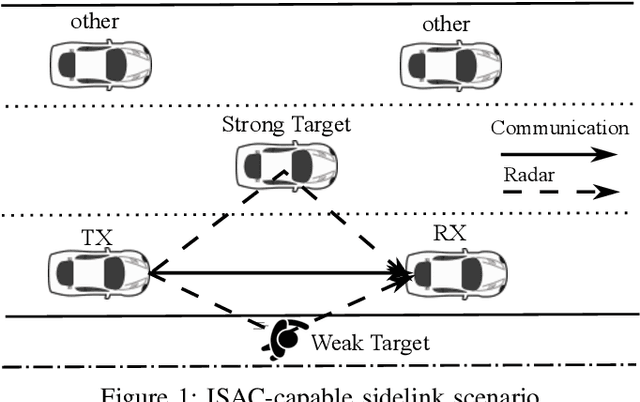
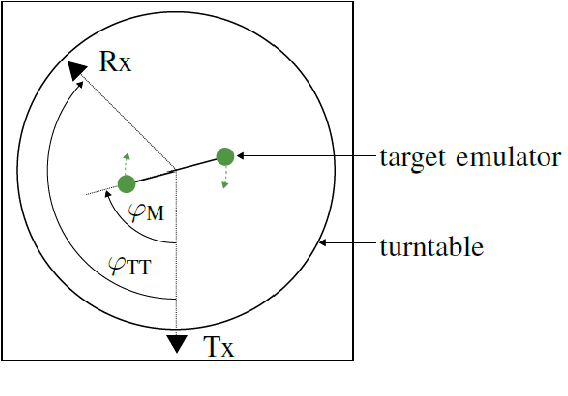
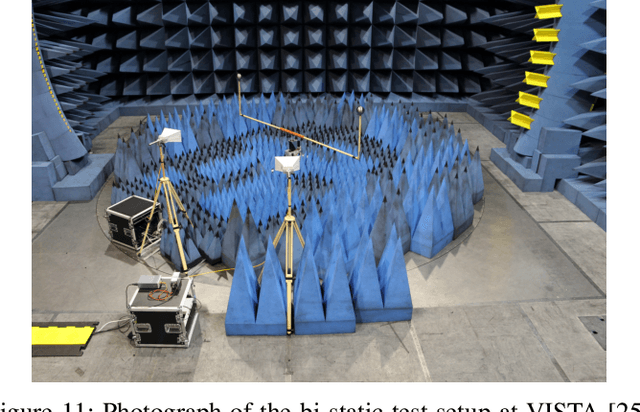
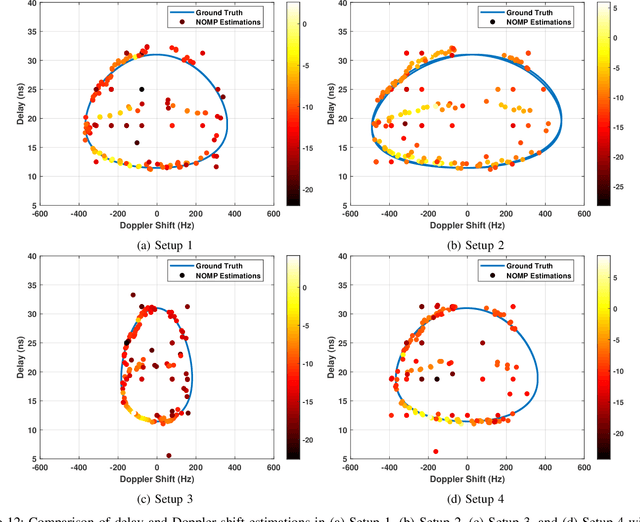
Abstract:Integrated Sensing and Communication (ISAC) is a technology paradigm that combines sensing capabilities with communication functionalities in a single device or system. In vehicle-to-everything (V2X) sidelink, ISAC can provide enhanced safety by allowing vehicles to not only communicate with one another but also sense the surrounding environment by using sidelink signals. In ISAC-capable V2X sidelink, the random resource allocation results in an unstructured and sparse distribution of time and frequency resources in the received orthogonal frequency division multiplexing (OFDM) grid, leading to degraded radar detection performance when processed using the conventional 2D-FFT method. To address this challenge, this paper proposes a high-resolution off-grid radar target detection algorithm irrespective of the OFDM grid structure. The proposed method utilizes the Newtonized orthogonal matching pursuit (NOMP) algorithm to effectively detect weak targets masked by the sidelobes of stronger ones and accurately estimates off-grid range and velocity parameters with minimal resources through Newton refinements. Simulation results demonstrate the superior performance of the proposed NOMP-based target detection algorithm compared to existing compressed sensing (CS) methods in terms of detection probability, resolution, and accuracy. Additionally, experimental validation is performed using a bi-static radar setup in a semi-anechoic chamber. The measurement results validate the simulation findings, showing that the proposed algorithm significantly enhances target detection and parameter estimation accuracy in realistic scenarios.
IoT Cloud RAN Testbed for Ultra-Precise TDoA-based Localization in LPWANs
Jan 21, 2024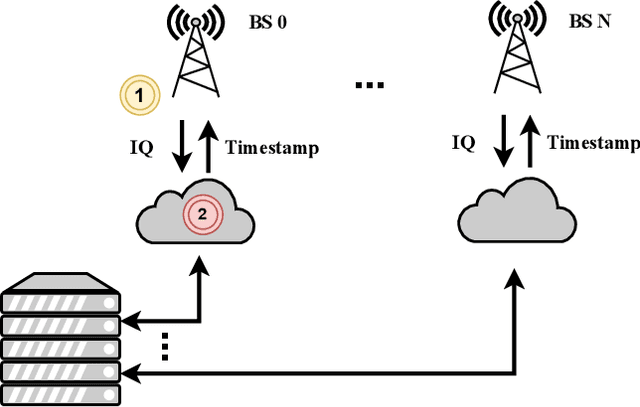
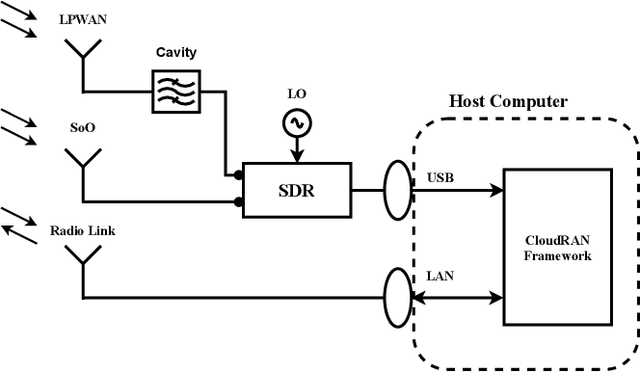
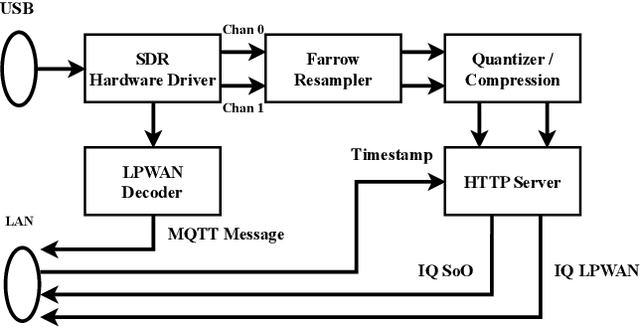
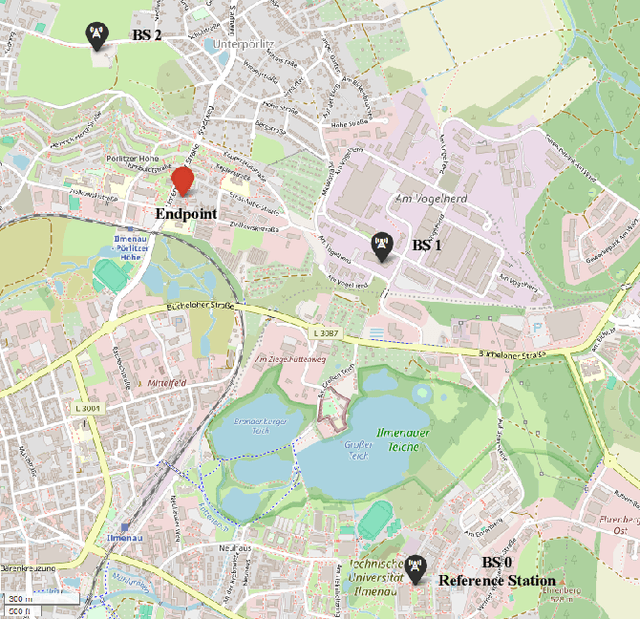
Abstract:There have been many research efforts in the area of localization in recent years. Especially within the Internet of Things (IoT), the knowledge of position information for individual components is of great interest, for example, in asset tracking, to name just one. However, many of these use cases require a high energy efficiency, making a GNSS-based approach infeasible. One promising candidate can be found in Low Power Wide Area Networks (LPWAN), which enable battery lifetimes of up to 20 years. However, no gold standard for localization exists for these types of networks. Our work proposes a testbed architecture that allows the investigation and development of localization algorithms within LPWA Networks. The concept is built on a Cloud Radio Access Network (CRAN) architecture that allows the streaming of IQ from remote base stations to a central processing unit. Furthermore, the architecture is expanded by a synchronization concept based on Signals of Opportunity (SoO) to enable the testbed for runtime-based positioning. Therefore, we propose a hardware concept consisting of antennas and a low-cost off-the-shelf software-defined radio (SDR)-based frontend architecture and a software framework using a hypertext transfer protocol (HTTP)-based server and client architecture. The proposed system is installed in an urban environment. Initial measurements are conducted, where it can be shown that the proposed architecture can be used for highly precise Time Difference of Arrival (TDoA) measurements, offering the possibility of time synchronization down to approximately 200 ps and frequency synchronization of 3 mHz.
Ultra-Precise Synchronization for TDoA-based Localization Using Signals of Opportunity
Jun 08, 2023Abstract:Precise localization is one key element of the Internet of Things (IoT). Especially concepts for position estimation when Global Navigation Satellite Systems (GNSS) are unavailable have moved into the focus. One crucial component for localization systems in general and precise runtime-based positioning, in particular, is the necessity of ultra-precise clock synchronization between the receiving base stations. Our work presents a software-based approach for the wireless synchronization of spatially separated base stations using a low-cost off-the-shelf frontend architecture. The proposed system estimates the time synchronization, sampling clock offset, and carrier frequency offset using broadcast signals as Signals of Opportunity. In this paper, we derive the theoretical lower bound for the estimation variance according to the Modified Cramer-Rao Bound. We show that a theoretical time synchronization accuracy in the range of ps and a frequency synchronization precision in the range of milli-Hertz is achievable. An algorithm is presented that estimates the desired parameter based on evaluating the Cross-Correlation Function between base stations. Initial measurements are conducted in a real-world environment. It is shown that the presented estimator nearly reaches the theoretical bound within a time and frequency synchronization accuracy of down to 200 ps and 6 mHz, respectively.
 Add to Chrome
Add to Chrome Add to Firefox
Add to Firefox Add to Edge
Add to Edge